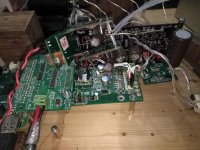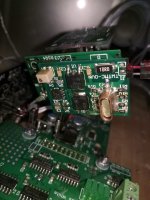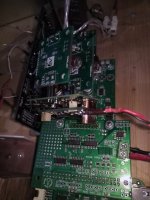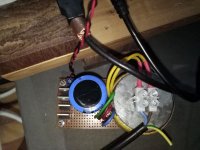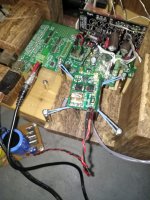Anybody know how much current the TWTMC-OVN needs?
Around 400 mA at startup and 200/250 mA when fully operational.
oven
over the weekend i managed to build the oven. the oven is very quick reaching the temperature and seems to be very stable.
i have set the temperature at 82°c with my dmm using its temperature probe (pt100 ? ) and the sc-cut with the oven sounds very nice as expected .
.
the oven pcb itself gets also relatively hot (Q1 becomes almost 120°c as reported before ) but everything seems to be very stable and trustable.
) but everything seems to be very stable and trustable.
next week i am going to check if i can hear any differences varying the temperature between 75°c-100°c and if so set the temperature at a level which sounds most pleasant for my taste.
big thank again to andrea for his great work!
over the weekend i managed to build the oven. the oven is very quick reaching the temperature and seems to be very stable.
i have set the temperature at 82°c with my dmm using its temperature probe (pt100 ? ) and the sc-cut with the oven sounds very nice as expected
the oven pcb itself gets also relatively hot (Q1 becomes almost 120°c as reported before
next week i am going to check if i can hear any differences varying the temperature between 75°c-100°c and if so set the temperature at a level which sounds most pleasant for my taste.
big thank again to andrea for his great work!
Attachments
@mr_whocares: Hi ... Thanks for your info - very interesting to get more information about the Oven. Looking forward to hearing about how the sound may vary with temperature ...


Jesper
big thank again to andrea for his great work!

Jesper
@mr_whocares: Hi ... Thanks for your info - very interesting to get more information about the Oven. Looking forward to hearing about how the sound may vary with temperature ...

Jesper
But what changes with temperature is the frequency. Very precision thermometers use crystal oscillators as temperature sensors. if you have an oven you really need decent insulation or it will change temperature with each passing drift of wind. Not hard to measure if you have a good freq counter with a stable time base (also a way to measure wind velocity).
Insulation will also reduce the power for the oven a lot.
But what changes with temperature is the frequency. Very precision thermometers use crystal oscillators as temperature sensors. if you have an oven you really need decent insulation or it will change temperature with each passing drift of wind. Not hard to measure if you have a good freq counter with a stable time base (also a way to measure wind velocity).
Insulation will also reduce the power for the oven a lot.
yes , your point is valid. however, it seems that the oven (copper tube) provide a sufficient thermal capacity. i have already did a test out of curiosity. even if you blow the oven for a short time the temperature changes just max. 2°c and the circuit can regulate it very quickly back to the set temperature. ... andrea did a very nice job with this simple and effective board! many thanks again!
i am not aware how is exactly the temperature dependency of our special sc-cut quartz. maybe andrea have more information about that and will share. however, as you mentioned an additional simple thermal isolation around the oven should be easy and does not harm ;-) . i will try that too.
best regards
SC cut set to its optimum turnover temp (different for every crystal) can be the least temperature sensitive. However its not zero. In audio terms its probably .00000001% of human pitch sensitivity. The insulation is to reduce power consumption. A good crystal oven can keep the temperature within .01 degree. For some applications this is essential but for audio not needed.
Hi,
finally found the time to finish and measure oscillators with Laptech SC-cut Xtal, 11.2896MHz. Phase noise is really good!
-112dBc @ 1Hz, -140dBc @ 10Hz , -154dBc @ 100Hz, -162dBc @ 1KHz , -164dBc @ 10KHz
Colpitts oscillator, design closely based on HP10811 OCXO schematic.
Phase noise measurement is diy based on Wenzel papers, 2 identical oscillators, a mixer , a low pas filter , amplifier and integrator for the PLL, low noise AC coupled 60dB amplifier for the measurement and a computer. Wenzel paper is very useful and makes phase noise measurements not that difficult!
First I measured commercial OCXO, 10MHz Morion found on ebay. Phase noise measurements matches datasheet data so my diy phase measurement setup should be not so wrong!
Had a quick test with AT cut Laptech AT cut Xtal. SC-cut are really much better.
I notice a quite big sensitivity to vibration, moving the mouse on the desk is easily measured at low frequency in the 10 to 20Hz range. Should be the resonating frequency of the desk. Looks like sensitivity is greater than Morion OCXO. Don't know if the reason is the Xtal in itself or if this point can be improve with an enclosure like the Morion one. Isolating very low frequency vibration is not an easy task...
The xtal have a strong resonance at 1KHz. While hearing the demodulated phase noise I had an acoustical feedback , larsen effect, as if the Xtal was a microphone! Acoustical level was quite low, coming from very small computer loudspeaker. So Xtal is a good microphone too!
Andrea, thank you to make this possible!
Joël
finally found the time to finish and measure oscillators with Laptech SC-cut Xtal, 11.2896MHz. Phase noise is really good!
-112dBc @ 1Hz, -140dBc @ 10Hz , -154dBc @ 100Hz, -162dBc @ 1KHz , -164dBc @ 10KHz
Colpitts oscillator, design closely based on HP10811 OCXO schematic.
Phase noise measurement is diy based on Wenzel papers, 2 identical oscillators, a mixer , a low pas filter , amplifier and integrator for the PLL, low noise AC coupled 60dB amplifier for the measurement and a computer. Wenzel paper is very useful and makes phase noise measurements not that difficult!
First I measured commercial OCXO, 10MHz Morion found on ebay. Phase noise measurements matches datasheet data so my diy phase measurement setup should be not so wrong!
Had a quick test with AT cut Laptech AT cut Xtal. SC-cut are really much better.
I notice a quite big sensitivity to vibration, moving the mouse on the desk is easily measured at low frequency in the 10 to 20Hz range. Should be the resonating frequency of the desk. Looks like sensitivity is greater than Morion OCXO. Don't know if the reason is the Xtal in itself or if this point can be improve with an enclosure like the Morion one. Isolating very low frequency vibration is not an easy task...
The xtal have a strong resonance at 1KHz. While hearing the demodulated phase noise I had an acoustical feedback , larsen effect, as if the Xtal was a microphone! Acoustical level was quite low, coming from very small computer loudspeaker. So Xtal is a good microphone too!
Andrea, thank you to make this possible!
Joël
I notice a quite big sensitivity to vibration, moving the mouse on the desk is easily measured at low frequency in the 10 to 20Hz range. Should be the resonating frequency of the desk. Looks like sensitivity is greater than Morion OCXO. Don't know if the reason is the Xtal in itself or if this point can be improve with an enclosure like the Morion one. Isolating very low frequency vibration is not an easy task...
The xtal have a strong resonance at 1KHz. While hearing the demodulated phase noise I had an acoustical feedback , larsen effect, as if the Xtal was a microphone! Acoustical level was quite low, coming from very small computer loudspeaker. So Xtal is a good microphone too!
Andrea, thank you to make this possible!
Joël
Great work. The Wenzel directions make it relatively possible to measure the phase noise. it still an ordeal and calibration looks pretty challenging per their directions.
In the past crystal microphones were a valid option. They take advantage of the piezo sensitivity of a crystal. Modulating the frequency through vibration is using the same effect. Possibly different holders and mechanical structures would make a difference. I suspect the 1 KHz resonance may be the holder on the PCB. If you have the opportunity to open one of the bigger ovens you will find several layers of stuff that effectively reduce vibration coupling. A double vacuum oven should have the least acoustic coupling.
Do either of your oscillators have varactor tuning diodes? It would be interesting to see how much modulation at audio frequencies is audible. It should correlate with jitter sensitivity but it may be different. The acoustic feedback you encountered may manifest itself as a "reverb". Curiously many people like a little reverb in their audio. It gives "life", "space" and "depth" to recordings.
jdlvfr, thank you for sharing with us your findings. Could you, please, provide the Laptech AT cut crystal measurement data as well?
Selfy, sorry I haven't saved the data. Measurements were far from expectations making me think of a faulty part or setup so in the investigation process I switched to sc-cut and haven't yet switch back to at-cut.
Let's say at-cut are 20 to 30dBc more at low offset but are better around 10KHz.
Joël
Great work. The Wenzel directions make it relatively possible to measure the phase noise. it still an ordeal and calibration looks pretty challenging per their directions.
In the past crystal microphones were a valid option. They take advantage of the piezo sensitivity of a crystal. Modulating the frequency through vibration is using the same effect. Possibly different holders and mechanical structures would make a difference. I suspect the 1 KHz resonance may be the holder on the PCB. If you have the opportunity to open one of the bigger ovens you will find several layers of stuff that effectively reduce vibration coupling. A double vacuum oven should have the least acoustic coupling.
Do either of your oscillators have varactor tuning diodes? It would be interesting to see how much modulation at audio frequencies is audible. It should correlate with jitter sensitivity but it may be different. The acoustic feedback you encountered may manifest itself as a "reverb". Curiously many people like a little reverb in their audio. It gives "life", "space" and "depth" to recordings.
You must be right with the holder, found an explanation here :
http://www.laptech.com/pdfs/HC-37-U_generic_data_sheet.pdf
High performance OCXO use HC35 or HC37 Xtal cases with 4 point mount for improved immunity to vibrations.
Varactor is needed for PLL operation so both have it. Hearing modulation effect is a nice idea, modulating with a dac would allow single tone or shaped noise. The hardest part is to find enough time!
Joël
Thank you, Joël. I am currently using off-the-shelf Crystek CCHD-957's with JLSounds XMOS board, directly powered by Salas BiB 3.3V supply. The improvement from the stock oscillators was considerable sound-wise. Now I am considering trying a discrete oscillator with good-quality crystal.
Measuring phase noise by mixing two identical oscillators can give unexpected results if they pull each other. It is very hard to completely avoid crosstalk
Yes, you are right. I think the reverse isolation of my oscillators is pretty good, I add an extra cascode transistor to the output buffer to the original HP schematic. But there is no shielding between the oscillators so coupling is possible.
Joël
Hi,
Today I finished putting together a TWTMC-D with 11.2896 AT cut crystal using LT3042 regs for both 3.3V and 6V supplies, raw supply coming from a regulated lead acid battery.
After first impression of hooking it up to my DAC I did not notice any improvement compared to Antons clock (Discrete Low Jitter Clock GB )
I let the system play while I was having dinner and after I came back after about 2 hours later and I noticed a small improvement (no beers or wine with dinner).
Is it likely that the crystal requires a long burn in time? I read a post a few pages back saying +100hrs of burn in is needed. What's other peoples experience?
Does anyone have a spare 11.2896 SC cut laptech crystal they want to sell?
Ryan
Today I finished putting together a TWTMC-D with 11.2896 AT cut crystal using LT3042 regs for both 3.3V and 6V supplies, raw supply coming from a regulated lead acid battery.
After first impression of hooking it up to my DAC I did not notice any improvement compared to Antons clock (Discrete Low Jitter Clock GB )
I let the system play while I was having dinner and after I came back after about 2 hours later and I noticed a small improvement (no beers or wine with dinner).
Is it likely that the crystal requires a long burn in time? I read a post a few pages back saying +100hrs of burn in is needed. What's other peoples experience?
Does anyone have a spare 11.2896 SC cut laptech crystal they want to sell?
Ryan
following the approach isolating the xo i tried today a 4point-suspension with rubber cords . in this quick&dirty test i isolated the whole set of twtmc-d, oven and 2x regulators.
the result is, indeed, very promising; everything sounds more relaxed and natural !
i will report more as soon as i have the chance to listen longer with this set-up.
regards
the result is, indeed, very promising; everything sounds more relaxed and natural !
i will report more as soon as i have the chance to listen longer with this set-up.
regards
Attachments
following the approach isolating the xo i tried today a 4point-suspension with rubber cords . in this quick&dirty test i isolated the whole set of twtmc-d, oven and 2x regulators.
the result is, indeed, very promising; everything sounds more relaxed and natural !
i will report more as soon as i have the chance to listen longer with this set-up.
regards
Very good concept,a platform in Panzerholtz would be even better.
- Status
- Not open for further replies.
- Home
- Source & Line
- Digital Line Level
- The Well Tempered Master Clock - Building a low phase noise/jitter crystal oscillator
